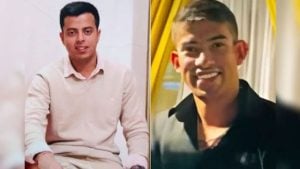Nobel Prize in Physics 2024 has been awarded to John Hopfield and Geoffrey Hinton. While Hopfield, 91, is an American scientist and has been long respected in the field of biological physics, the British-Canadian Hinton, 76, has been called the ‘godfather of Artificial Intelligence’ (AI).
Nobel Prize In Physics To AI Pioneers
Why In News
- Nobel Prize in Physics 2024 has been awarded to John Hopfield and Geoffrey Hinton. While Hopfield, 91, is an American scientist and has been long respected in the field of biological physics, the British-Canadian Hinton, 76, has been called the ‘godfather of Artificial Intelligence’ (AI).
Mimicking The Brain
- The big success of Hopfield and Hinton has been in developing computer algorithms that mimic the functioning of the human brain in performing common tasks.
- Computers were invented to carry out repetitive calculation-based tasks that were too time-consuming for humans. But very soon, scientists began wondering whether machines could also be made to do things that humans seemed to be far better at — remembering, recognising, creating, learning, and making intelligent guesses.
- Human brain broadly accumulates and processes information in three ways: through noticing the world around, through memory, and through the effort it puts in learning new things. The human brain can also think, using the stored information for various purposes.
- As the Nobel website points out, today, machines can’t think, but can copy human functions of memory and learning. For example, a human brain, including that of a child, can look at an animal and tell it is a cat, even if it is a species of cat the child has never encountered before. Teaching a computer similar skills can mean that it can look at various pictures of human cells, and tell which cell is likely to be cancer-affected.
- This stage has been reached after decades of research, which at times flagged because the results were discouraging. Hopfield and Hinton, working separately, have made major contributions in this research.
What John Hopfield Did
- Suppose you used a particular perfume regularly in a certain stage of your life. Years later, you smell that perfume somewhere, and memories of that time come flooding back. This process is called associative memory, and this is what was central in Hopfield’s work, who built an artificial network of nodes to store information, mimicking the human brain.
- Each node could store an individual value, of either 0 or 1. As the Nobel website says, “The Hopfield network can store patterns and has a method for recreating them.
- When the network is given an incomplete or slightly distorted pattern, the method can find the stored pattern that is most similar.”
- While the first version of this network was built in the 1980s, Hopfield and other researchers have continued to improve upon it.
What Geoffrey Hinton Did
- Hinton started from the Hopfield network and “expanded it to build something new, using ideas from statistical physics,” the Nobel website says. Along with other researchers, he built something called the Boltzmann machine, which used an equation developed by the nineteenth-century physicist Ludwig Boltzmann.
- ‘The Boltzmann machine can learn – not from instructions, but from being given examples A trained Boltzmann machine can recognise familiar traits in information it has not previously seen.
- Imagine meeting a friend’s sibling, and you can immediately see that they must be related. In a similar way, the Boltzmann machine can recognise an entirely new example if it belongs to a category found in the training material, and differentiate it from material that is dissimilar,” the Nobel website says.


























